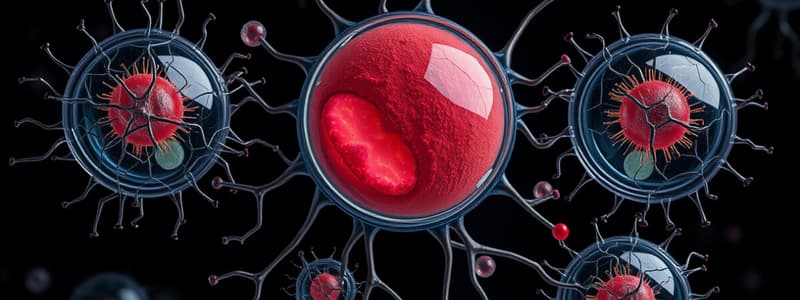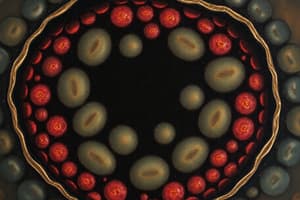Podcast
Questions and Answers
Which statement about the cell theory is incorrect?
Which statement about the cell theory is incorrect?
- All living organisms are made up of multiple cells.
- Cells can arise from non-living matter under laboratory conditions. (correct)
- Cells carry genetic information in the form of DNA.
- Cells are the basic structural unit of all living things.
What is not a characteristic of viruses?
What is not a characteristic of viruses?
- They may use RNA as genetic material.
- They are acellular structures.
- They can reproduce independently. (correct)
- They require a host cell to reproduce.
Which of the following organelles is responsible for synthesizing ribosomal RNA?
Which of the following organelles is responsible for synthesizing ribosomal RNA?
- Nucleus
- Lysosome
- Mitochondria
- Nucleolus (correct)
What structure is directly responsible for the exchange of materials between the nucleus and the cytosol?
What structure is directly responsible for the exchange of materials between the nucleus and the cytosol?
Which statement accurately describes mitochondria?
Which statement accurately describes mitochondria?
What is the primary function of lysosomes?
What is the primary function of lysosomes?
Which component of the cell membrane contributes to its hydrophobic core?
Which component of the cell membrane contributes to its hydrophobic core?
Which of the following correctly describes the endoplasmic reticulum (ER)?
Which of the following correctly describes the endoplasmic reticulum (ER)?
What occurs during the lag phase of bacterial growth?
What occurs during the lag phase of bacterial growth?
What is NOT a characteristic of viruses?
What is NOT a characteristic of viruses?
Which of the following statements about retroviruses is correct?
Which of the following statements about retroviruses is correct?
Which statement best describes transduction in bacteria?
Which statement best describes transduction in bacteria?
What defines a virus as a bacteriophage?
What defines a virus as a bacteriophage?
How do prions alter protein structure?
How do prions alter protein structure?
Which phase in the bacterial growth cycle is characterized by cell death?
Which phase in the bacterial growth cycle is characterized by cell death?
What distinguishes lysogenic cycles from lytic cycles in bacteriophages?
What distinguishes lysogenic cycles from lytic cycles in bacteriophages?
What is the primary function of tail fibers in bacteriophages?
What is the primary function of tail fibers in bacteriophages?
Which of the following correctly describes the role of viroids?
Which of the following correctly describes the role of viroids?
What is the primary function of the rough endoplasmic reticulum (RER)?
What is the primary function of the rough endoplasmic reticulum (RER)?
Which structure contributes to the organization of microtubules in the mitotic spindle?
Which structure contributes to the organization of microtubules in the mitotic spindle?
What is the structural feature that characterizes Gram-positive bacteria?
What is the structural feature that characterizes Gram-positive bacteria?
What role do intermediate filaments play within the cell?
What role do intermediate filaments play within the cell?
What distinguishes facultative anaerobes from obligate anaerobes?
What distinguishes facultative anaerobes from obligate anaerobes?
Which cellular structure is primarily responsible for detoxification in the cell?
Which cellular structure is primarily responsible for detoxification in the cell?
What type of epithelial tissue appears to have multiple layers due to varying cell heights?
What type of epithelial tissue appears to have multiple layers due to varying cell heights?
Which bacterial shapes is characterized as being rod-shaped?
Which bacterial shapes is characterized as being rod-shaped?
What happens during the transformation process in bacteria?
What happens during the transformation process in bacteria?
What is the significance of the pentose phosphate pathway in peroxisomes?
What is the significance of the pentose phosphate pathway in peroxisomes?
Which type of connective tissue provides insulation and energy storage?
Which type of connective tissue provides insulation and energy storage?
What structure acts as the primary energy propulsion mechanism for bacteria?
What structure acts as the primary energy propulsion mechanism for bacteria?
In what aspect do archaea differ from bacteria?
In what aspect do archaea differ from bacteria?
Which of the following structures is primarily associated with the synthesis of lipids?
Which of the following structures is primarily associated with the synthesis of lipids?
Study Notes
Cell Theory
- Composed of four main tenets:
- All living organisms consist of cells.
- Cells are the fundamental units of life.
- New cells arise only from existing cells.
- Genetic information is stored in DNA and transmitted during cell division.
- Viruses are classified as acellular entities; they require a host to reproduce and may utilize RNA instead of DNA.
Eukaryotic Cells
-
Eukaryotic cells feature:
- Membrane-bound organelles and a defined nucleus.
- Phospholipid bilayers in cell membranes and organelles, providing selective permeability.
- Cytosol that allows for molecular diffusion and organelle suspension.
-
Key eukaryotic organelles:
- Nucleus: Contains DNA in chromosomes; surrounded by a nuclear envelope with pores for material exchange.
- Nucleolus: Site of ribosomal RNA synthesis.
- Mitochondria: Double-membraned organelles involved in energy production via the electron transport chain and capable of independent division. Can initiate cell death (apoptosis).
- Lysosomes: Contain enzymes for breaking down waste; can cause cell autolysis.
- Endoplasmic Reticulum (ER): Network of membranes; rough ER (RER) synthesizes proteins; smooth ER (SER) synthesizes lipids and detoxifies.
- Golgi Apparatus: Modifies, packages, and directs proteins and lipids to their destinations.
- Peroxisomes: Break down fatty acids and hydrogen peroxide; contribute to lipid synthesis.
-
Cytoskeleton:
- Provides structural integrity and transportation pathways.
- Composed of microfilaments (actin), microtubules (tubulin), and intermediate filaments (e.g., keratin).
- Microtubules form cilia and flagella with a 9+2 organization and are involved in cell motility.
Epithelial Tissues
- Function: Protects against pathogens and desiccation, involved in absorption, secretion, and sensation.
- Cell polarity: Epithelial cells have distinct surfaces (apical and basal).
- Classification:
- By layers: Simple (one layer), stratified (multiple layers), pseudostratified (appears multi-layered but is single).
- By cell shape: Cuboidal (cube-like), columnar (rectangular), squamous (flat).
Connective Tissues
- Provide structural support to epithelial tissues.
- Form the stroma of organs by secreting materials for the extracellular matrix.
- Examples: Bone, cartilage, tendons, ligaments, adipose tissue, blood.
Prokaryotic Cells
- Characterized by the absence of membrane-bound organelles; genetic material in a single circular DNA molecule in the nucleoid.
- Two domains: Archaea (extremophiles) and Bacteria.
- Bacterial classification by shape:
- Cocci (spherical), bacilli (rod-shaped), spirilli (spiral).
- Classification based on oxygen requirements:
- Obligate aerobes, obligate anaerobes, facultative anaerobes, aerotolerant anaerobes.
- Bacterial envelope comprises the cell wall and membrane, regulating substance movement.
Bacterial Staining
- Gram staining differentiates bacteria:
- Gram-positive (purple): Thick peptidoglycan layer.
- Gram-negative (pink): Thin peptidoglycan plus an outer membrane with lipopolysaccharides.
Bacterial Mobility
- Bacteria may have flagella for movement towards or away from stimuli (chemotaxis).
- Structure: Filament (flagellin), basal body, and hook.
Genetics and Growth in Prokaryotes
- Binary fission for reproduction: chromosome replication and cell division.
- Plasmids: Extrachromosomal DNA that may confer advantages (e.g., antibiotic resistance).
- Genetic recombination methods:
- Transformation (uptake of DNA from the environment),
- Conjugation (direct transfer between bacteria),
- Transduction (via bacteriophage).
- Bacterial growth phases: Lag phase, exponential phase, stationary phase, death phase.
Viruses and Subviral Particles
- Viruses consist of genetic material, a protein coat (capsid), and potentially a lipid envelope; obligate intracellular parasites.
- Bacteriophages: Viruses that infect bacteria, utilizing specialized structures for injection of genetic material.
- Viral genomes can be DNA or RNA, single or double-stranded; retroviruses reverse transcribe RNA into DNA.
Viral Replication and Lifecycle
- Entry into host cells can occur via receptor binding, membrane fusion, or endocytosis.
- Viral progeny are released through lysis or exocytosis.
- Bacteriophages undergo different life cycles:
- Lytic cycle: Rapid replication leading to cell lysis.
- Lysogenic cycle: Integration into the host genome; can reactivate to lytic cycle.
Prions and Viroids
- Prions: Infectious proteins that induce protein misfolding, disrupting normal cellular functions.
- Viroids: Small RNA molecules that impair gene expression in plants, potentially causing cell death.
Studying That Suits You
Use AI to generate personalized quizzes and flashcards to suit your learning preferences.
Description
Test your knowledge on the fundamental principles of cell theory and the characteristics of eukaryotic cells. This quiz will cover topics such as the composition of cells, their functions, and the genetic material they carry. Challenge yourself and solidify your understanding of these essential biological concepts.




